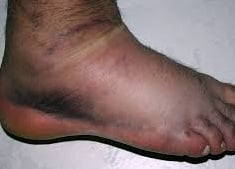 A sprain is an injury that occurs when a joint or ligament is twisted or stretched suddenly and excessively, causing pain . Sprains generate inflammation in the affected area, where a hematoma also appears due to the accumulation of blood.
A sprain is an injury that occurs when a joint or ligament is twisted or stretched suddenly and excessively, causing pain . Sprains generate inflammation in the affected area, where a hematoma also appears due to the accumulation of blood.
These injuries, which prevent normal mobility of the joint, can be caused by a blow or an unnatural movement. It is important not to confuse the sprain with a tear (which affects the muscle) or with a dislocation (in this case, the joint changes position and separates from the bone).
Depending on the severity of the injury, in everyday speech we can simply recognize mild sprains (those that do nothing more than strain the ligaments) and serious sprains (if the ligaments are torn or cut). On the other hand, it is possible to talk about three types of sprains, as distinguished by professionals:
Grade I sprain : It is also known as entorsis . It occurs when the ligament is partially stretched , that is, there is no tearing (the ligament is not violently separated from the bone) or breakage. During clinical examination, such a sprain allows the patient to perform movements in an apparently normal manner, but a certain degree of swelling is noted. Through appropriate treatment, it is possible for the patient to recover completely and have no sequelae;
* grade II sprain : its main characteristic is that the ligaments are totally or partially torn. The pain is very strong and the joint movements are too wide. Generally, it is possible to recover completely, although the duration of treatment is longer than in grade I cases, and may leave sequelae of varying severity;
* grade III sprain : the ligament is completely torn and bone tearing also occurs. All of this can lead to a dislocation if joint congruity is completely lost. An x-ray is usually performed to observe the bone injury. Typically, moderate or severe sequelae remain, with persistent pain, instability, and stiffness.
At a general level, beyond the different intensities, it can be said that all sprains cause swelling and pain , generating certain functional problems. The most common sprains occur in the thumb, wrist and ankle.
 Among football players, for example, knee sprains are common. In tennis, shoulder sprains predominate, while in basketball , ankle sprains usually occur.
Among football players, for example, knee sprains are common. In tennis, shoulder sprains predominate, while in basketball , ankle sprains usually occur.
But these dualities are nothing more than mere examples of a very detailed table that specialists have developed over time, based on statistical data from their patients. Let's see below which sports usually generate injuries in each of the most affected parts of the body:
* volleyball : ankle, knee and fingers;
* basketball : ankle, knee, elbow, shoulder, back and fingers;
* football : ankle and knee;
* rugby : the ankle, knee, elbow and shoulder;
* tennis : the ankle, knee, elbow and shoulder.
There is much more data collected by doctors, but the list above mentions some of the most common sports . Among those that have been left out are skateboarding , taekwondo , parkour and paintball .
The treatment of a sprain includes, as a first measure, rest . The area must remain motionless and not be subjected to stress. For immobilization , bandages or dressings that allow compression can be used. On the other hand, inflammation can be combated with ice and by elevating the affected limb relative to the rest of the body.
